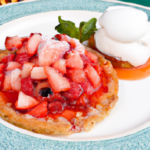Have you ever wondered what makes Canadian food and wine so unique and delicious? Well, get ready to satisfy your taste buds and embark on a culinary adventure as we explore the food and wine scene in Canada. From coast to coast, Canada offers a diverse range of culinary delights that will leave you wanting more. In this article, we’ll delve into the rich history and cultural influences that have shaped Canadian cuisine, and we’ll take you on a virtual tour of some of the must-visit food and wine destinations across the country.
Bite into a slice of maple-glazed salmon in British Columbia, sip on a glass of ice wine in Ontario’s picturesque vineyards, or indulge in the beloved national dish, poutine, in Quebec – these are just a taste of what Canada has to offer. As we dive deeper, we’ll uncover the unique flavors and ingredients that define Canadian cuisine. From the hearty comfort foods of the prairies to the fresh seafood of the Atlantic coast, each region showcases its own culinary traditions and local specialties. Whether you’re a foodie looking to expand your palate or a wine connoisseur seeking new tastes, this article will introduce you to the best of Canada’s food and wine scene. So get ready to discover the incredible flavors that make Canada a true culinary destination. Stay tuned for more mouth-watering details in the upcoming paragraphs!
Taste of Canada: Exploring the Food and Wine Scene
As a foodie, you can’t miss out on the opportunity to explore the vibrant food and wine scene in Canada. With its diverse culinary traditions and unique wine regions, Canada offers a captivating gastronomic experience that will leave you craving for more. Let’s dive into the Taste of Canada and discover the rich tapestry of flavors that this country has to offer.
Canadian Cuisine
Canada’s food culture is deeply influenced by its historical and regional diversity. Over the years, Canadian cuisine has been shaped by the traditions brought by immigrants from different parts of the world. From the First Nations people to European settlers, each group has contributed its own unique culinary heritage, resulting in a vibrant and eclectic culinary landscape.
Historical Influences
The historical influences on Canadian cuisine are vast and varied. Indigenous ingredients and cooking techniques laid the foundation for the country’s culinary traditions. European settlers introduced their own flavors and cooking methods, creating a fusion of old and new. British, French, and Italian influences are particularly prominent in Canadian cuisine.
Regional Specialties
Canada’s vast geographical landscape and diverse climates contribute to the development of unique regional specialties. From the hearty seafood dishes of the East Coast to the rich and flavorful cuisine of Quebec, each region has its own distinct flavors and culinary treasures. Make sure to indulge in fresh seafood in the Maritimes, sample poutine in Quebec, and savor the wild game in the Prairie provinces.
Traditional Dishes
When it comes to traditional Canadian dishes, there are a few classics that you must try. One such dish is tourtière, a savory meat pie that originated in Quebec. Made with ground meat and spices, it is a staple during the holiday season. Another must-try is the butter tart, a sweet treat consisting of a pastry shell filled with a gooey butter and sugar filling. And of course, no Canadian food tour is complete without indulging in a plate of poutine – French fries smothered in cheese curds and gravy.
Indigenous Cuisine
Indigenous cuisine is an integral part of Canadian culinary heritage. Aboriginal communities across Canada have a deep connection with the land and its resources, and their traditional ingredients and cooking techniques are celebrated in modern Canadian cuisine. From Pacific salmon to bison and wild blueberries to fiddleheads, the flavors of Indigenous cuisine will take you on a journey through the rich history and culture of Canada.

Food Festivals and Events
The best way to immerse yourself in the Canadian food scene is to attend one of the many food festivals and events that take place throughout the year. These events showcase the diverse flavors and culinary talents of the country and offer a unique opportunity to indulge in a variety of delicious dishes.
Poutine Fest
Poutine, Canada’s beloved comfort food, takes center stage at Poutine Fest. This festival celebrates everything poutine, with vendors serving up their own unique twists on this classic dish. From traditional poutine to gourmet versions topped with lobster or pulled pork, there’s something for every palate.
Maple Syrup Fest
Canada is famous for its maple syrup, and Maple Syrup Fest is a celebration of this sweet liquid gold. Held during the sugaring off season, this festival offers visitors a chance to learn about maple syrup production, sample different grades of syrup, and indulge in maple-infused dishes and treats.
Lobster Festival
If you’re a seafood lover, you can’t miss the Lobster Festival in the Maritimes. This annual event celebrates the bounty of the Atlantic Ocean, with lobster being the star of the show. From lobster boils to lobster rolls, you’ll have plenty of opportunities to savor this delicacy in all its glory.
Wine Tasting Events
Canada’s wine industry has been flourishing in recent years, with wine regions across the country producing world-class wines. From the Niagara Peninsula in Ontario to the Okanagan Valley in British Columbia, wine tasting events allow you to explore the different varietals and styles of Canadian wine. Whether you’re a wine connoisseur or just enjoy a glass of vino, these events offer a unique opportunity to discover the hidden gem that is Canadian wine.
Celebrity Chefs
Canada is home to a talented and innovative group of celebrity chefs who have put Canadian cuisine on the map. These culinary trailblazers have not only shaped the Canadian food scene but have also garnered international recognition for their outstanding culinary skills and unique interpretations of local flavors.
Top Canadian Chefs
From the groundbreaking farm-to-table philosophy of Michael Smith to the inventive fusion cuisine of Susur Lee, Canada boasts a roster of top-notch chefs. Other notable names include Lynn Crawford, known for her emphasis on fresh and local ingredients, and Vikram Vij, whose Indian-inspired cuisine has captivated taste buds around the world. These chefs have not only elevated Canadian cuisine but have also inspired a new generation of culinary talent.
Innovative Culinary Techniques
Canadian chefs are known for their innovative culinary techniques, often blending traditional flavors with modern cooking methods. Sous-vide cooking, molecular gastronomy, and foraging for wild ingredients are just a few examples of the innovative techniques embraced by Canadian chefs. This commitment to pushing culinary boundaries has made Canada a hotspot for food experimentation and innovation.
International Recognitions
Canadian chefs have earned their place on the international culinary stage, with numerous accolades and recognition. From Michelin stars to James Beard Awards, Canadian chefs have been shining a spotlight on the country’s vibrant food scene. The international recognition has not only put Canadian cuisine on the global map but has also drawn food enthusiasts from around the world to experience the culinary delights that Canada has to offer.

Canadian Wine Regions
Canada’s wine regions have been gaining recognition for their exceptional wines. From cool-climate whites to robust reds, the country’s diverse terroirs produce a range of wines that showcase the unique characteristics of each region.
Niagara Peninsula
The Niagara Peninsula in Ontario is Canada’s most famous wine region. Its moderate climate, influenced by the Great Lakes, is ideal for growing a variety of grape varietals. Riesling, Chardonnay, and Cabernet Franc are among the standout wines produced in this region. A visit to the Niagara Peninsula should include stops at wineries such as Inniskillin, Jackson-Triggs, and Tawse.
Okanagan Valley
British Columbia’s Okanagan Valley boasts stunning landscapes and a burgeoning wine industry. The region is known for its dry, sunny climate and diverse microclimates, which allow for the production of a wide range of wines. From crisp whites like Sauvignon Blanc and Pinot Gris to bold reds such as Merlot and Syrah, the wines of the Okanagan Valley never fail to impress. Mission Hill, Quails’ Gate, and Burrowing Owl are some of the wineries worth visiting in the area.
Prince Edward County
Located on Lake Ontario, Prince Edward County is a relatively new wine region that has quickly gained acclaim for its cool-climate wines. Chardonnay and Pinot Noir are the stars of the show here, with wineries like Norman Hardie, Closson Chase, and Rosehall Run producing exceptional examples of these varietals. The region’s scenic beauty and charming wineries make it a must-visit destination for wine lovers.
Similkameen Valley
Tucked between the Okanagan Valley and the Cascade Mountains, the Similkameen Valley is a hidden gem of Canadian wine regions. The area’s warm, dry climate is ideal for growing grapes, particularly organic and biodynamic varieties. This region is known for its rich, full-bodied red wines, as well as unique varietals like Carmenere and Malbec. Orofino, Clos du Soleil, and Eau Vivre are just a few of the wineries worth exploring in the Similkameen Valley.
Ice Wine
When it comes to Canadian wine, one cannot ignore the unique and exquisite ice wines produced in the country. Ice wine is a sweet and luxurious treat made from grapes that have frozen on the vine. The production process is labor-intensive and requires precise timing and temperatures.
Production Process
To make ice wine, grapes are left on the vine until they freeze, usually in late autumn or early winter. Once frozen, the grapes are harvested and pressed while still frozen, resulting in a concentrated juice with high sugar levels. This juice is then fermented and aged to produce the final ice wine, known for its intense sweetness and flavors.
Renowned Ice Wine Producers
Canada is renowned for its ice wines, with producers in the Niagara Peninsula and the Okanagan Valley leading the way. Inniskillin and Jackson-Triggs are two iconic wineries that have become synonymous with Canadian ice wine. These wineries have consistently produced exceptional ice wines that have garnered international acclaim.
Serving and Pairing
Ice wine is best enjoyed chilled and served in small quantities due to its sweetness. It pairs well with rich desserts, such as crème brûlée and chocolate cake, as well as with blue cheeses and foie gras. Its natural acidity also allows it to cut through the richness of spicy Asian cuisine, making it a versatile choice for food pairings.
Farm-to-Table Movement
Canada’s farm-to-table movement has gained momentum in recent years, with a growing emphasis on sustainable agriculture practices and local sourcing. This movement seeks to connect consumers with the food they eat, promoting a closer relationship between farmers, chefs, and consumers.
Sustainable Agriculture Practices
Farmers across Canada are adopting sustainable agriculture practices to minimize their environmental impact. This includes organic farming methods, crop rotation, and the use of natural fertilizers and pest control techniques. By prioritizing sustainable practices, farmers ensure the long-term health of the land and contribute to the preservation of Canada’s natural resources.
Local Sourcing
The farm-to-table movement encourages restaurants and consumers to source their ingredients locally. By supporting local farmers and producers, the movement aims to reduce the carbon footprint associated with long-distance food transportation and support the local economy. It also allows for the use of fresh, seasonal ingredients, resulting in dishes that are bursting with flavor and nutritional value.
Community Supported Agriculture
Community Supported Agriculture (CSA) programs have become increasingly popular in Canada. These programs allow consumers to purchase a subscription or membership directly from a local farm, receiving a weekly or monthly supply of fresh produce and other farm products. CSA programs not only provide individuals with access to high-quality, locally grown food but also foster a sense of community and connection to the land.
Street Food Culture
Street food has become an integral part of Canada’s culinary landscape, offering a taste of global flavors right on the streets of Canadian cities. Food trucks have risen in popularity, becoming mobile kitchens that serve up a wide variety of delicious and affordable dishes.
Food Trucks
Food trucks have become synonymous with street food culture in Canada. From tacos and poutine to gourmet burgers and fusion cuisine, you can find a food truck serving just about any type of cuisine you can imagine. These mobile kitchens allow chefs to showcase their creativity and bring their culinary creations to the masses.
Popular Street Food
Some popular street foods in Canada include variations of poutine, such as butter chicken poutine and lobster poutine. Other favorites include gourmet hot dogs, Korean BBQ tacos, and wood-fired pizzas. These street food offerings provide a quick and convenient way to experience a diverse range of flavors without breaking the bank.
International Inspirations
Street food in Canada draws inspiration from around the world, reflecting the country’s multiculturalism. You can find dishes influenced by Asian, Middle Eastern, and Latin American cuisines, among others. Whether it’s a homemade roti, a steaming bowl of ramen, or a Lebanese shawarma, street food offers a culinary journey through the flavors of different cultures.
Unique Canadian Ingredients
Canada is blessed with a wide variety of unique and flavorful ingredients that reflect its natural resources and diverse ecosystems. From the rich waters of the Atlantic to the bountiful forests of British Columbia, these ingredients are at the heart of Canadian cuisine.
Pacific Salmon
Pacific salmon is one of Canada’s most iconic ingredients. Known for its rich flavor and buttery texture, this fish is celebrated in culinary traditions across the country. From grilled cedar plank salmon to smoked salmon bagels, there are countless delicious ways to enjoy this Canadian delicacy.
Bison
Bison has deep roots in Indigenous cuisine and is now gaining popularity as a lean and sustainable alternative to beef. Raised in the prairies, bison meat is known for its rich flavor and tender texture. From bison burgers to bison steaks, this versatile meat offers a unique taste of the Canadian wilderness.
Wild Blueberries
Wild blueberries are a beloved ingredient in Canadian cuisine, offering a burst of flavor and natural sweetness. These small, intensely flavored berries are native to Canada and thrive in the country’s cool climates. They are used in a wide range of dishes, from pies and muffins to jams and sauces.
Fiddleheads
Fiddleheads are the young shoots of ferns and are harvested in the spring. These delicately curled greens have a unique flavor that is often compared to a combination of asparagus and spinach. Fiddleheads are a seasonal treat in Canada and are typically enjoyed steamed or sautéed as a side dish or incorporated into salads and pasta dishes.
Fine Dining Experiences
Canada’s fine dining scene offers a delightful blend of creativity, flavor, and impeccable service. From award-winning restaurants to inventive menus, you’ll find a wealth of options to indulge in a truly memorable culinary experience.
Award-Winning Restaurants
Canada is home to numerous award-winning restaurants that have earned international acclaim. From the iconic Toqué! in Montreal to the innovative Hawksworth in Vancouver, these establishments showcase the best of Canadian cuisine. Whether it’s a multi-course tasting menu or an à la carte experience, dining at these renowned restaurants is a journey through the flavors of Canada.
Inventive Menus
Canadian chefs are known for their inventive menus that celebrate local flavors and seasonal ingredients. Menus often feature dishes inspired by different regions of Canada, showcasing the country’s culinary diversity. From foraged ingredients to unexpected flavor combinations, you’ll find that Canadian cuisine is anything but ordinary.
Ambience and Services
In addition to the exceptional food, fine dining experiences in Canada often offer exquisite ambience and top-notch service. Many restaurants boast stunning views of the surrounding landscapes, whether it’s the Toronto skyline or the mountains of British Columbia. Impeccable service and attention to detail ensure that dining at these establishments is a truly special occasion.
Conclusion
Canada’s food and wine scene offers a delightful tapestry of flavors, traditions, and innovation. From the rich history of Canadian cuisine to the emerging wine regions, every bite and sip tell a story. So go ahead, explore the Taste of Canada, indulge in delicious dishes, and toast to the exquisite wines that make Canada a true culinary destination.



